The OCZ Vector 180 (240GB, 480GB & 960GB) SSD Review
by Kristian Vättö on March 24, 2015 2:00 PM EST- Posted in
- Storage
- SSDs
- OCZ
- Barefoot 3
- Vector 180
AnandTech Storage Bench - The Destroyer
The Destroyer has been an essential part of our SSD test suite for nearly two years now. It was crafted to provide a benchmark for very IO intensive workloads, which is where you most often notice the difference between drives. It's not necessarily the most relevant test to an average user, but for anyone with a heavier IO workload The Destroyer should do a good job at characterizing performance.
| AnandTech Storage Bench - The Destroyer | ||||||||||||
| Workload | Description | Applications Used | ||||||||||
| Photo Sync/Editing | Import images, edit, export | Adobe Photoshop CS6, Adobe Lightroom 4, Dropbox | ||||||||||
| Gaming | Download/install games, play games | Steam, Deus Ex, Skyrim, Starcraft 2, BioShock Infinite | ||||||||||
| Virtualization | Run/manage VM, use general apps inside VM | VirtualBox | ||||||||||
| General Productivity | Browse the web, manage local email, copy files, encrypt/decrypt files, backup system, download content, virus/malware scan | Chrome, IE10, Outlook, Windows 8, AxCrypt, uTorrent, AdAware | ||||||||||
| Video Playback | Copy and watch movies | Windows 8 | ||||||||||
| Application Development | Compile projects, check out code, download code samples | Visual Studio 2012 | ||||||||||
The table above describes the workloads of The Destroyer in a bit more detail. Most of the workloads are run independently in the trace, but obviously there are various operations (such as backups) in the background.
| AnandTech Storage Bench - The Destroyer - Specs | ||||||||||||
| Reads | 38.83 million | |||||||||||
| Writes | 10.98 million | |||||||||||
| Total IO Operations | 49.8 million | |||||||||||
| Total GB Read | 1583.02 GB | |||||||||||
| Total GB Written | 875.62 GB | |||||||||||
| Average Queue Depth | ~5.5 | |||||||||||
| Focus | Worst case multitasking, IO consistency | |||||||||||
The name Destroyer comes from the sheer fact that the trace contains nearly 50 million IO operations. That's enough IO operations to effectively put the drive into steady-state and give an idea of the performance in worst case multitasking scenarios. About 67% of the IOs are sequential in nature with the rest ranging from pseudo-random to fully random.
| AnandTech Storage Bench - The Destroyer - IO Breakdown | |||||||||||
| IO Size | <4KB | 4KB | 8KB | 16KB | 32KB | 64KB | 128KB | ||||
| % of Total | 6.0% | 26.2% | 3.1% | 2.4% | 1.7% | 38.4% | 18.0% | ||||
I've included a breakdown of the IOs in the table above, which accounts for 95.8% of total IOs in the trace. The leftover IO sizes are relatively rare in between sizes that don't have a significant (>1%) share on their own. Over a half of the transfers are large IOs with one fourth being 4KB in size.
| AnandTech Storage Bench - The Destroyer - QD Breakdown | ||||||||||||
| Queue Depth | 1 | 2 | 3 | 4-5 | 6-10 | 11-20 | 21-32 | >32 | ||||
| % of Total | 50.0% | 21.9% | 4.1% | 5.7% | 8.8% | 6.0% | 2.1% | 1.4 | ||||
Despite the average queue depth of 5.5, a half of the IOs happen at queue depth of one and scenarios where the queue depths is higher than 10 are rather infrequent.
The two key metrics I'm reporting haven't changed and I'll continue to report both data rate and latency because the two have slightly different focuses. Data rate measures the speed of the data transfer, so it emphasizes large IOs that simply account for a much larger share when looking at the total amount of data. Latency, on the other hand, ignores the IO size, so all IOs are given the same weight in the calculation. Both metrics are useful, although in terms of system responsiveness I think the latency is more critical. As a result, I'm also reporting two new stats that provide us a very good insight to high latency IOs by reporting the share of >10ms and >100ms IOs as a percentage of the total.
I'm also reporting the total power consumed during the trace, which gives us good insight into the drive's power consumption under different workloads. It's better than average power consumption in the sense that it also takes performance into account because a faster completion time will result in less watt-hours consumed. Since the idle times of the trace have been truncated for faster playback, the number doesn't fully address the impact of idle power consumption, but nevertheless the metric is valuable when it comes active power consumption.
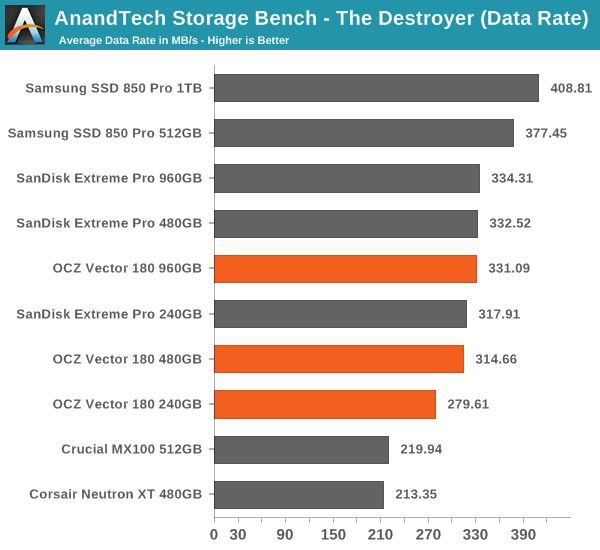
For a high-end drive, the Vector 180 has average data rate in our heaviest 'The Destroyer' trace. At 480GB and 960GB it's able to keep up with the Extreme Pro, but the 240GB model doesn't bear that well when compared to the competition.
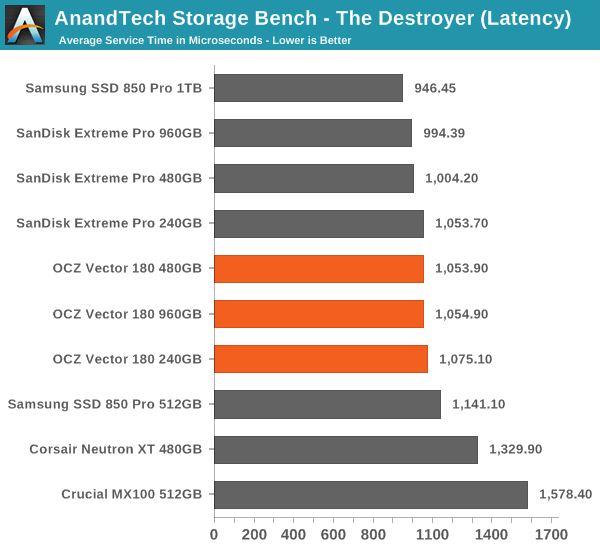
The same story continues when looking at average latency, although I have to say that the differences between drives are quite marginal. What's notable is how consistent the Vector 180 is regardless of the capacity.
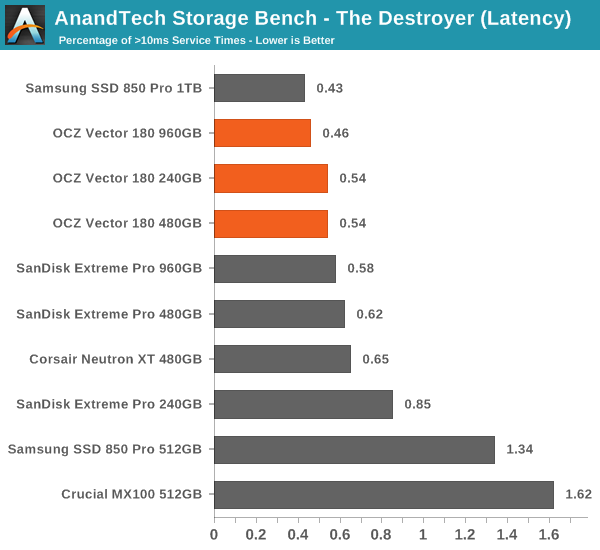
Positively, the Vector 180 has very few high latency IOs and actually leads the pack when looking at all capacities.
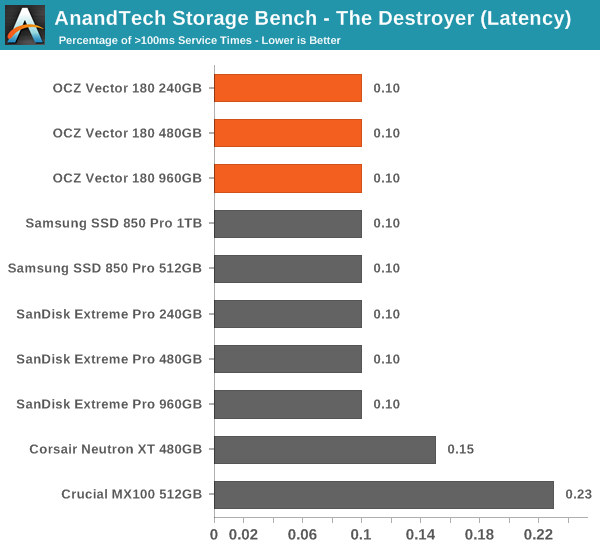
The Vector 180 also appears to be very power efficient under load and manages to beat every other SSD I've run through the test so far. Too bad there is no support for slumber power modes because the Barefoot 3 seems to excel otherwise when it comes to power.
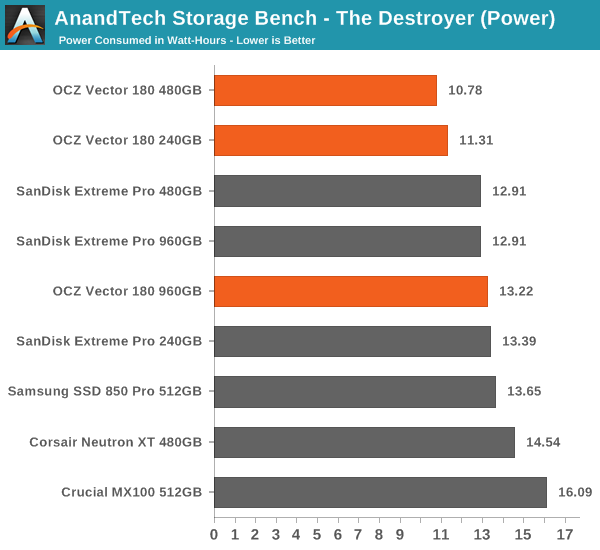










89 Comments
View All Comments
nils_ - Wednesday, March 25, 2015 - link
I distinctly remember that when I replaced a SSD in my workstation the Acronis tool, instead of copying my data from the source SSD to the new SSD copied the data to another, unrelated HDD in the system, happily overwriting the Linux partitions stored thereon... I had to unplug everything from the mainboard safe for the old and new SSD to make sure that it doesn't destroy any more of my data.MikeMurphy - Wednesday, March 25, 2015 - link
Macrium Reflect is free and wonderful to use.mapesdhs - Wednesday, March 25, 2015 - link
Yep, MR is what I use, it works very well and has a good interface.
Ian.
JonnyDough - Tuesday, March 31, 2015 - link
Thirded. It works wonderfully.The_Assimilator - Tuesday, March 24, 2015 - link
OCZ is still beating that Barefoot 3 dead horse for all it's worth. No wonder they went bankrupt. If you don't innovate, you die.ocztosh - Tuesday, March 24, 2015 - link
Hello The_Assimilator. Thanks for your comments. Innovation is definitely a key area of focus for us on both the client and enterprise sides of our SSD business. We currently have a lot of resources put on next generation controllers and have been working hard on client SSDs leveraging the latest Toshiba NAND flash, which includes TLC. While some of these products are on the horizon it was natural for us to update our Vector Series with A19 NAND flash, and rather than just make a NAND change we wanted to add new features not normally found in our client class products like power fail management plus (PFM+) to further improve reliability in applications that blur the line between enthusiast and workstation.It is true that Barefoot 3 has, and continues to be, a very strong platform for us as we have shipped so many drives based on this in-house controller, and it has been so solid that we have not had to rev silicon a single time. We will continue to push to innovate when it comes to SSD performance, features and cost and are committed to delivering more value for all our customers. Thanks again for your feedback.
Minion4Hire - Tuesday, March 24, 2015 - link
The bigger problem is that the SSD market has stagnated. When their weren't major players (like Samsung) the little guy could cobble something together and make a decent living filling what was a niche market. Now SSDs are mainstream, and through volume alone the big guys can overpower the little guys, let alone R&D, etc. Until the market shifts away from SATA there's no room for niche innovation or clever advances. It's all down to margins right now.Samus - Tuesday, March 24, 2015 - link
You do realize the two best-selling controllers are Marvell and Sandforce, and both are older than Barefoot 3. The SF2281 is 3+ years old and still ships in a variety of Mushkin, ADATA, Intel, etc SSD's.Barefoot 3 is thoroughly modern, but it does lack some power saving and drive encryption features. I don't think it makes sense for OCZ to update it when PCIe is around the corner and will require a new controller since a bridge will be expensive and not much faster.
Aside from that, Barefoot 3 is incredibly innovative. I consider it the best controller available aside from Intel's 3rd gen controller (equally as old) and Samsung's MEX. ASMedia is still a little inconsistent and featureless, Marvell has an aging indirection table implementation that yields average performance, Phison is clearly entry-level with relatively low performance and consistency, Silicon Motion and Fusion-IO are power hungry, have quirks with certain NAND varieties and are not cost competitive.
Guspaz - Tuesday, March 24, 2015 - link
"There's an old saying in Tennessee - I know it's in Texas, probably in Tennessee - that says, fool me once, shame on - shame on you. Fool me - you can't get fooled again."Yeah, George, I'm not planning on getting fooled by OCZ again.
blue_urban_sky - Tuesday, March 24, 2015 - link
Is that the saying from Tennessee where they cant't remember the proper saying?